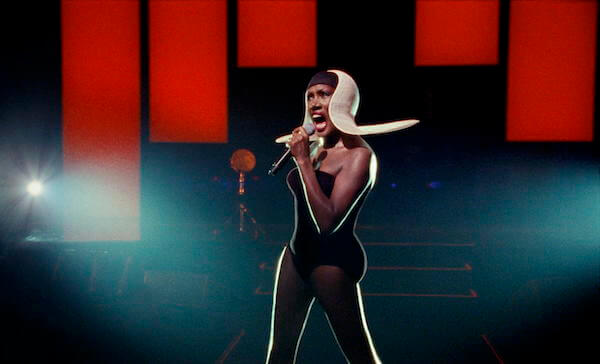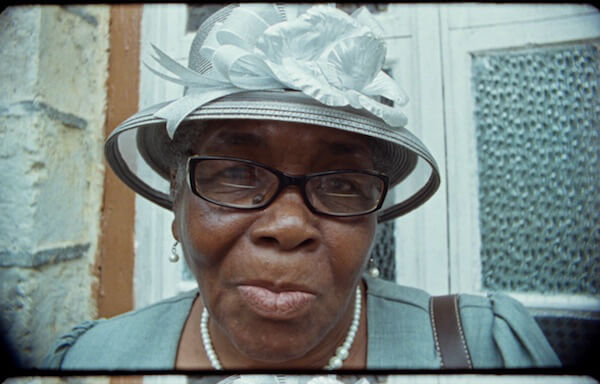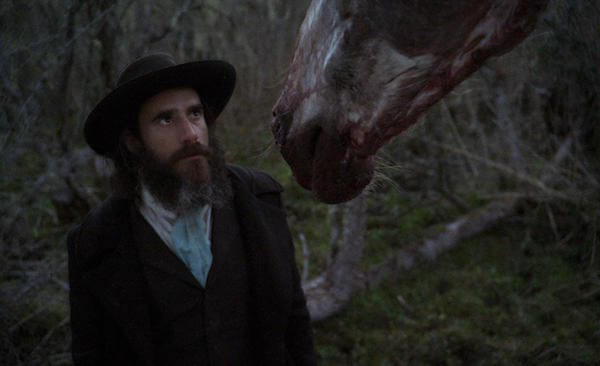Grace Jones, as seen in Sophie Fiennes’ “Grace Jones: Bloodlight and Bami.” | KINO LORBER
How does anyone approach the inimitable, indomitable Grace Jones? The singer/ actress/ model turns 70 this year and still has impeccably sculpted legs and cheekbones, a distinctive, throaty voice, her androgynous appearance, and an outré sense of fashion. She is utterly unconventional and totally alluring. In a remarkable documentary, “Grace Jones: Bloodlight and Bami,” director and editor Sophie Fiennes reveals her subject’s essence in performances and personal moments.
The film opens with the singer performing her hit song “Slave to the Rhythm” on stage, dressed in a mask in one scene and gyrating with a rainbow-colored hula-hoop in another. These performance scenes are a testament to her showmanship, and as adoring fans greet her outside the stage door there is no doubt she deserves the worship.
But Fiennes is not looking to discuss Jones’ art and craft or personal story and struggles. Instead, the film captures unique moments such as Jones being whisked back to her homeland, Jamaica, where she reconnects with her family. In a series of observational scenes, Jones talks with her mother and siblings about their collective history, drinks fresh coconut water, and shucks some tricky bivalve mollusks, observing candidly that she wishes her pussy was as tight as these mussels.
Sophie Fiennes captures enlightening, poignant moments of 70-year-old enigma
“Grace Jones: Bloodlight and Bami” conveys unmistakably that its subject does not mince words. She reacts badly to collaborators canceling studio time she paid for, and she pushes back regarding a performance where she claims she has been made to look like a “lesbian madame in a whorehouse” — because her backup dancers are gyrating on a tacky set in negligée-like costumes. Jones later yells during a phone call about an unsigned contract and hotel room issues. Her anger is justified in each situation, and such scenes indicate how much harder the performer has to work to get what she deserves — especially since she is doing the work. Her demanding behavior in such moments reveals more about Jones’ perfectionism than any interview might.
Those episodes are also reflected in Jones’ song lyrics. When she sings “This Is,” her refrain “They tried to strip me of dignity/ but I still have tenacity” speaks volumes. Likewise, her song “Williams’ Blood” has more meaning after viewers meet Jones’ mother, Marjorie Jones (née Williams), and get snippets of her family history.
Jones is absolutely hypnotic on stage. The dozen performance scenes are infectious, each one a riot of music, color, and style. Her appearances are dazzling, from her makeup — she does her eyebrows in one scene and “goes tribal,” painting her face, in another — to her wearing a sparkly bowler hat and some fabulous headwear.
Jones also comments on her androgyny. Her remark that appearing masculine emphasizes “dominant and scary” qualities makes sense in light of what viewers learn about Jones’ strict father. Acting, she explains, was one way for her to deal with the difficulties she faced growing up with him.
The documentary makes clear just how conscious Jones is of what she presents on screen, including when she is seen fully naked. Jones carefully constructs her image, both on-stage and off.
Viewers will no doubt appreciate the unfiltered candor of Jones’ remarks.
In talking about a fight that broke out on live TV, she insists she “doesn’t strike without a warning,” but elsewhere says, “Sometimes you gotta be a high-flying bitch.” Provocatively, she also argues, “Men should be penetrated at least once to know what it is like to receive.”
Fiennes is adept at capturing moments both big — such as Jones accompanying her mother to church, where Marjorie sings for the congregation — and small, as when Grace reveals her skill at playing jacks.
The opportunity to see Jones strut on stage to perform “Pull Up to the Bumper,” as well as “Warm Leatherette,” “Love Is the Drug,” and “Nipple to the Bottle,” among other classics, is irresistible. Seeing her acknowledge she was surprised her version of “La vie en rose” became a disco hit is gratifying. It is nice to see her appreciate an unexpected success.
That kind of humility comes across throughout the film; Jones is not always seen as fierce or being a diva. She achieves a measure of poignancy when she talks about her late father’s “death eyes.” It’s a touching moment in a portrait that never aims to demystify Jones, but rather simply presents her as she is and shows Grace Jones just being Grace Jones.
GRACE JONES: BLOODLIGHT AND BAMI | Directed by Sophie Fiennes | Kino Lorber | Opens Apr. 13 | Metrograph | 7 Ludlow St. btwn. Hester & Canal Sts.; metrograph.com | BAMcinématek, 30 Lafayette Ave. at St. Felix St., Brooklyn; bam.org | Film Society of Lincoln Center, 144-165 W. 65th St.; filmlinc.org






































